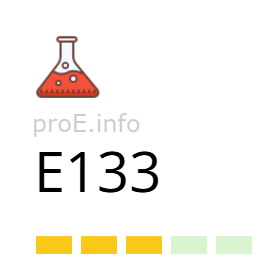
Other names for the additive (synonyms)
General Information
Food additive E133 (Brilliant Blue FCF) is a synthetic triarylmethane dye obtained through organic synthesis. The raw materials for its production are products of coal tar distillation, which is a complex mixture of carbon-containing compounds and a byproduct of the coal industry.
To produce food-grade E133 dye, a complex process is used, including sulfonation reactions and the formation of the sodium salt of the dye. The chemical formula of the finished product (additive E133) is C37H34N2Na2O9S3.
In appearance, additive E133 is a reddish-blue powder that is poorly soluble in water, which is due to the specific features of its molecular structure.
The physicochemical properties of additive E133 include resistance to changes in temperature and pH during food processing. In addition, Brilliant Blue FCF is resistant to light exposure, which is important for preserving the color of products during storage.
Historically, the synthesis and use of triarylmethane dyes began in the 19th century with the development of the dye industry, and Brilliant Blue FCF became one of the widely used artificial food colorants. Today, in the food industry, additive E133 is used as a colorant to give bright blue and green shades to various products. It can be mixed with other azo dyes (E102, E104, E110, E122, E124) to achieve desired colors and shades.
Effects on the Body
Benefits of Additive E133
Although food additive E133 is not a biologically active substance, there is scientific evidence suggesting a possible therapeutic effect under certain conditions. One study on laboratory rats showed that additive E133 may promote tissue regeneration in spinal cord injuries, improving the recovery of nerve functions. However, these findings have not yet been confirmed by clinical trials in humans and require further research.
Harm of Additive E133
Additive E133 is poorly absorbed from the human gastrointestinal tract — about 95% of the ingested dye is excreted from the body with feces. When interacting with certain bile pigments, additive E133 may give waste products a greenish hue.
In some sensitive individuals, especially those with asthma or aspirin intolerance, allergic reactions may occur, including breathing difficulties and skin manifestations.
In recent years, the potential toxic effects of synthetic dyes, including additive E133, have been actively studied.
At present, there is no strong evidence of carcinogenicity, mutagenicity, or reproductive toxicity. Studies conducted by EFSA and JECFA confirm that when acceptable intake levels are observed, additive E133 is safe for human consumption.
Exceeding the acceptable daily intake (ADI) may increase allergic symptoms and cause other side effects.
In 2010, the EFSA Panel on Food Additives and Nutrient Sources added to Food, in its scientific opinion on the safety assessment of Brilliant Blue FCF (E133), lowered the acceptable daily intake to 6 mg/kg body weight per day.
In 2025, the FDA announced plans to phase out the use of synthetic azo dyes (including additive E133) in food products by the end of 2026.
Uses
Additive E133 is widely used in the food industry as a dye that gives products a bluish or greenish hue. It is most commonly used in the production of:
- ice cream, jelly, and gelatin desserts
- soft drinks
- confectionery (candies, chewing gum)
- some dairy products
- breakfast cereals and other products where a stable blue color is required.
In addition to the food industry, E133 is used in cosmetics (creams, shampoos, deodorants, hair dyes) and in pharmaceuticals for coloring medicinal products.
Legal Status
Additive E133 is approved for use in many countries around the world. In the European Union, it is authorized under Regulation (EC) No 1333/2008 with an acceptable daily intake (ADI) set at 6 mg per kilogram of body weight. In Ukraine, additive E133 is also authorized for use in the food industry in accordance with European legislation.
In the United States, the Food and Drug Administration (FDA) has approved the use of FD&C Blue dye in food products. At the same time, there are plans to phase out the use of azo dyes in the U.S. food industry by the end of 2026.
In Canada, Japan, and several other countries, additive E133 is included in the list of permitted food colorants.
However, some European countries, such as Belgium, France, Denmark, Norway, and Germany, have introduced restrictions or bans on the use of additive E133 in children's and certain other products due to the risk of allergic reactions and the lack of sufficient data on the long-term effects of the additive on health.